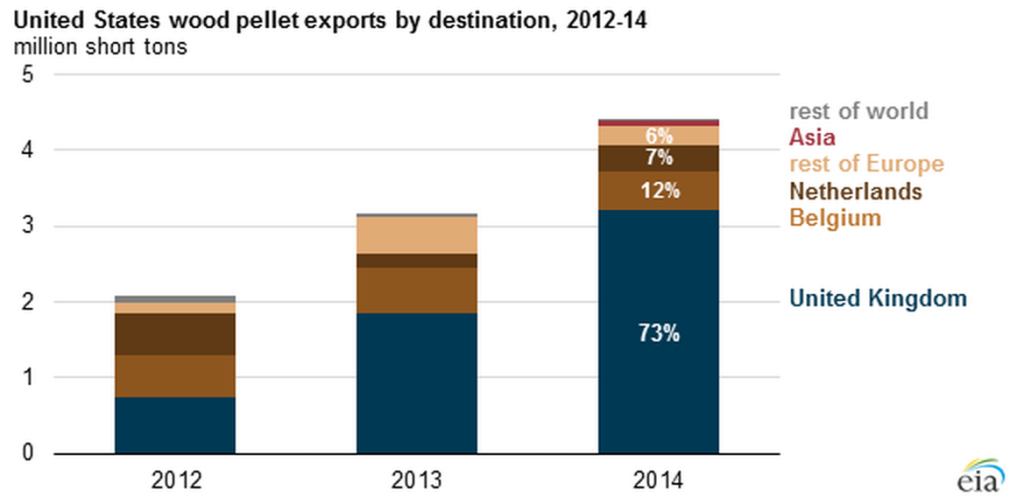The European Union has pledged to reduce greenhouse gas emissions by at least 40 percent by 2030 from 1990 levels to attain an 80 percent reduction by 2050.[i] To do so, it has set a target for renewable energy to meet at least 27 percent of its energy consumption by 2030. But that renewable energy is not just composed of wind and solar power. European countries have also turned to wood pellets for electricity generation despite the fact that the combustion of wood emits greenhouse gases. And, the United States has become a major exporter of wood pellets that supply European generators.
What are Wood Pellets?
Wood pellets are made from wood byproducts such as chips, bark and sawdust, and from tree tops, branches and other forestry debris remaining after a tree trunk has been processed. The wood is milled, dried and pelletized in a specialty press. During the process, the lignin in the wood plasticizes, forming a natural glue that holds the pellet together. Pellet sizes vary from one-fourth to one-third inches in diameter and 1 to 1.5 inches long.[ii] Wood pellets are used in wood-burning stoves for heating homes and businesses, as fuel for small-scale industrial boilers, and for utility-scale electricity generation.
Wood Pellets in the UK
Wood pellets are taking the place of coal in many European power plants to reduce carbon dioxide emissions. The United Kingdom, for example, is relying on the use of wood pellets in co-firing with coal or in dedicated biomass power plants as part of its plan to reduce greenhouse gas emissions. In the United Kingdom’s plan, renewable energy must supply 15 percent of the country’s energy demand by 2020. As a result, large coal-fired power plants in the UK have either been retrofitted to co-fire with wood pellets or have been converted to dedicated biomass plants.
Electricity generation in the UK from plant-based biomass, including wood pellets, increased by 47 percent between 2013 and 2014–from 8,933 gigawatthours in 2013 to 13,138 gigawatthours in 2014[iii]. The main user of the wood pellets is the Drax power plant in north-central England, which is being converted from coal to biomass—the largest such project in Europe. The Drax plant is composed of six units that total almost 4 gigawatts of capacity. The first unit was converted to a dedicated biomass unit in 2013; a second unit was first co-fired and then converted to a dedicated biomass unit in 2014; and a third unit’s conversion is planned for 2015/2016.[iv] Only 2.8 percent of Drax’s wood pellet supply is produced in the UK. In 2014, 58 percent of the Drax plant’s wood pellets was supplied by the United States, followed by Canada providing 22 percent. The remaining wood pellet supply came from other countries in Europe and South Africa.[v]
Drax Biomass, a wholly owned subsidiary of the Drax Group, owns and operates several pellet manufacturing mills in the southern United States. Two such mills–Amite Bioenergy and Morehouse BioEnergy in Mississippi and Louisiana, respectively–have a combined annual capacity of almost 1 million short tons. Drax Group is expected to build more pellet mills in the United States in the future.[vi]
U.S. Exports of Wood Pellets
Since 2012, the United States has been the world’s largest exporter of wood pellets, relegating Canada to the number two spot. Wood pellet exports from the United States increased from 3.2 million short tons in 2013 to 4.4 million short tons in 2014—an increase of almost 40 percent. In 2014, 92 percent of U.S. wood pellet exports were delivered to Europe with the UK receiving the lion’s share (73 percent). According to the U.S. International Trade Commission, U.S. wood pellet exports accounted for more than $500 million of trade in 2014.[vii]
Source: Energy Information Administration, http://www.eia.gov/todayinenergy/detail.cfm?id=20912
According to Biomass Magazine, there are 184 wood pellet plants in the United States with a capacity of 21,889 billion short tons.[viii] Global demand for wood pellets is expected to more than double over the next decade–from an estimated 23 million metric tons in 2014 to 50 million metric tons in 2024[ix]–and more wood pellet mills are expected in the United States, particularly in the southeastern states. The U.S. South has about 40 percent of the country’s timberland, which supplies the lumber, pulp, and paper industries.[x]
Conclusion
Environmental regulations in Europe have spurred a huge increase in the demand for forest byproducts from the United States, making the United States the number one exporter of wood pellets. The United States exported 4.4 million short tons of wood pellets in 2014 and that market is expected to grow as global demand for wood pellets is expected to almost double over the next decade. Europe is a large consumer of U.S. wood pellets, particularly the UK, who is trying to meet its renewable energy targets by converting coal-fired power plants to biomass. However, the combustion of biomass, as well as the transport from the United States, does emit carbon dioxide, so it is unclear how much the UK and other European countries are gaining from the conversion.
[i] European Commission, 2030 framework for climate and energy policies, http://ec.europa.eu/clima/policies/2030/index_en.htm
[ii] Star News, Demand for wood pellets in Europe a boon to southeast U.S., April 6, 2013, http://www.starnewsonline.com/article/20130406/articles/130409747?p=1&tc=pg&tc=ar
[iii] UK government, Energy Trends: renewables, April 9, 2015, https://www.gov.uk/government/uploads/system/uploads/attachment_data/file/415998/renewables.pdf
[iv] Drax, Our biomass plans, http://www.drax.com/biomass/our-biomass-plans/
[v] Drax, Biomass Supply, February 2015, http://www.drax.com/media/56583/biomass-supply-report-2014.pdf
[vi] Biomass Magazine, Drax plans another Mississippi pellet plant, May 21, 2014, http://biomassmagazine.com/articles/10423/drax-plans-another-mississippi-pellet-plant
[vii] Energy Information Administration, UK’s renewable energy targets drive increases in U.S. wood pellet exports, April 22, 2015, http://www.eia.gov/todayinenergy/detail.cfm?id=20912
[viii] Biomass Magazine, Pellet Plants, http://biomassmagazine.com/plants/listplants/pellet/US/
[ix] RISI News, September 3, 2014, http://www.risiinfo.com/pages/abo/news/latest/Global-wood-pellet-demand-to-reach-50-million-tonnes-by-2024-Rapid-demand-growth-largely-driven-by-European-industrial-and-heat-markets-and-Asian-industrial-markets.html
[x] National Geographic, The Energy Boom You Haven’t Heard About: Wood Pellets, December 20, 2014, http://news.nationalgeographic.com/news/energy/2014/12/141208-wood-pellet-energy-boom-driven-by-exports/
